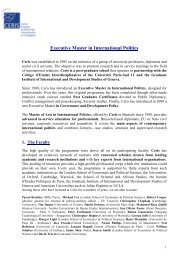hydropolitics of the tigris - euphrates river basin with - ceris.be
hydropolitics of the tigris - euphrates river basin with - ceris.be
hydropolitics of the tigris - euphrates river basin with - ceris.be
Create successful ePaper yourself
Turn your PDF publications into a flip-book with our unique Google optimized e-Paper software.
28 Daoudy, M., Water, Institutions and Development in Syria: A Downstream Perspective from <strong>the</strong> Euphrates and<br />
Tigris, (World Commission on Dams Report, Serial No: env 108), p.11. Daoudy also remarks on <strong>the</strong> phenomena that<br />
<strong>the</strong> value attributed to agriculture, in and <strong>of</strong> itself, far exceeds its economic value due to its strongly instilled cultural,<br />
symbolic, political and military significance.<br />
29 McQuarrie, p.42-44.<br />
30 Hillel, p. 108.<br />
31 McQuarrie, p. 46.<br />
32 Hillel, p.109, remarks on <strong>the</strong> lack <strong>of</strong> pr<strong>of</strong>essional and administrative expertise, especially in <strong>the</strong> instance where much<br />
<strong>of</strong> <strong>the</strong> land prepared for irrigation from <strong>the</strong> Tabqa Dam was found to <strong>be</strong> unsuitable.<br />
33 McQuarrie, p.80.<br />
34 Daoudy, In 1982 all water-related acts were unified into one law and <strong>the</strong> Ministry <strong>of</strong> Irrigation were formed in 1983,<br />
supervising industrial, agricultural and human water consumption. p.5.<br />
35 Ibid. p. 99, Lake Abu-Dibbis has a storage capacity <strong>of</strong> 45 BCM and Lake Tharthar BCM.<br />
36 Shapland, G., Rivers <strong>of</strong> Discord, (Hurst and Company, London, 1997), p.109.<br />
37 Hillel, The Third River is a canal augmented by feeder canals and drainage pipes to draw away saline agricultural<br />
return flow.p.100.<br />
38 Partow, H., The Mesopotamian Marshlands: Demise <strong>of</strong> an Ecosystem, (Early Warning and Assessment Technical<br />
Report, UNEP/DEWA/TR.01-3 Rev.1, 2001), pp.22-23. Partow emphasises that <strong>the</strong> original design would not have<br />
resulted in marshland drainage as such, and was technically sound <strong>be</strong>cause irrigation <strong>with</strong>out drainage is ultimately<br />
unsustainable. The design did, however, provide <strong>the</strong> broader framework from which <strong>the</strong> marshland drainage plan was<br />
derived.<br />
39 McQuarrie, Initially production did rise until <strong>the</strong> mid-1990’s. Farmers were required to crop all lands every year (no<br />
rotation) and many gate valves for flood irrigation were left open for days which increased <strong>with</strong>drawals from <strong>the</strong> <strong>river</strong>s.<br />
At <strong>the</strong> end <strong>of</strong> <strong>the</strong> day, <strong>the</strong>se unstable agricultural methods coupled <strong>with</strong> untimely droughts <strong>be</strong>gan to reduce <strong>the</strong><br />
agricultural production. p.70.<br />
40 Partow, p.24.<br />
41 McQuarrie, states that in <strong>the</strong> year following <strong>the</strong> Gulf War agricultural production dropped by 50%. This included <strong>the</strong><br />
failure <strong>of</strong> <strong>the</strong> national date crop, due to raw sewage <strong>be</strong>ing dumped directly into <strong>the</strong> Tigris River.<br />
42 McQuarrie, Iraq claimed rights to 16.1bcm/year from <strong>the</strong> Euphrates based on a 1965 World Bank study. Syria’s<br />
<strong>with</strong>drawal for <strong>the</strong> Tabqa reduced <strong>the</strong> flow to 9.4bcm/year. Iraq subsequently claimed that this reduction had resulted<br />
in a loss <strong>of</strong> 70% <strong>of</strong> agricultural potential and threatened three million farmers dependent on <strong>river</strong> irrigation. p.73.<br />
43 Shapland, comments that <strong>the</strong>re was a strong antagonism <strong>be</strong>tween <strong>the</strong> two Ba’athist regimes in Baghdad and<br />
Damascus who were both continually vying for pan-Arab influence and would use any excuse to accuse each o<strong>the</strong>r <strong>of</strong><br />
hostile acts. p.117.<br />
44 Hillel, p.109, McQuarrie, pp.73-74, & Shapland, who mentions that <strong>the</strong> Arab League tried first to mediate <strong>the</strong><br />
situation, unsuccessfully, and later was replaced by Saudi Arabia and <strong>the</strong> Soviets who secured <strong>the</strong> additional release<br />
<strong>of</strong> water. pp. 117-118.<br />
45 McQuarrie, p.75 & Shapland, who writes that in any case <strong>the</strong> Arab partners laid a claim to 700m 3 /s from <strong>the</strong><br />
Euphrates to <strong>be</strong> shared <strong>be</strong>tween <strong>the</strong>m both. p.119.<br />
46 Adams, p. 27.<br />
47 McQuarrie, pp. 75-76.<br />
48 Adams, comments that “Water and <strong>the</strong> PKK were political and strategic levers on ei<strong>the</strong>r side.”, p;28.<br />
49 Hillel, p.189, and McQuarrie, p.54.<br />
50 Shapland, Syria and Lebanon signed and agreement in 1994 (after some twenty years <strong>of</strong> discussions) in which <strong>the</strong><br />
allocation <strong>of</strong> Orontes water was agreed upon. As part <strong>of</strong> this agreement Lebanon could continue to draw water from<br />
existing wells in <strong>the</strong> Orontes Basin but would not <strong>be</strong> permitted to drill new wells. p.144.<br />
51 ibid., This distribution also reflects <strong>the</strong> degree <strong>of</strong> influence that Syria holds over Lebanon.p.145.<br />
52 McQuarrie, p.79.<br />
53 Shapland, Syria is almost obliged to link this rhetoric to her territorial claims to Hatay Province <strong>be</strong>cause she has yet<br />
to take a strategic decision <strong>be</strong>tween her claims to Hatay versus her claims to <strong>the</strong> Euphrates. This is a weakness,<br />
exploited by Turkey again in 1995 when <strong>the</strong> same complaint was raised by Turkey to counter Syrian objections to<br />
continuing projects on <strong>the</strong> Euphrates (in this case <strong>the</strong> construction <strong>of</strong> <strong>the</strong> Birecik Dam), p.146<br />
54 Carkoglu, A., and Eder, M., Water Conflict: The Euphrates-Tigris Basin, in Turkey in World Politics: An emerging<br />
Multi-regional Power, Rubin B. & Kirisci K. eds. (Lynne Rienner Publishers, 2001), The trade <strong>be</strong>tween Turkey and Iraq<br />
40





